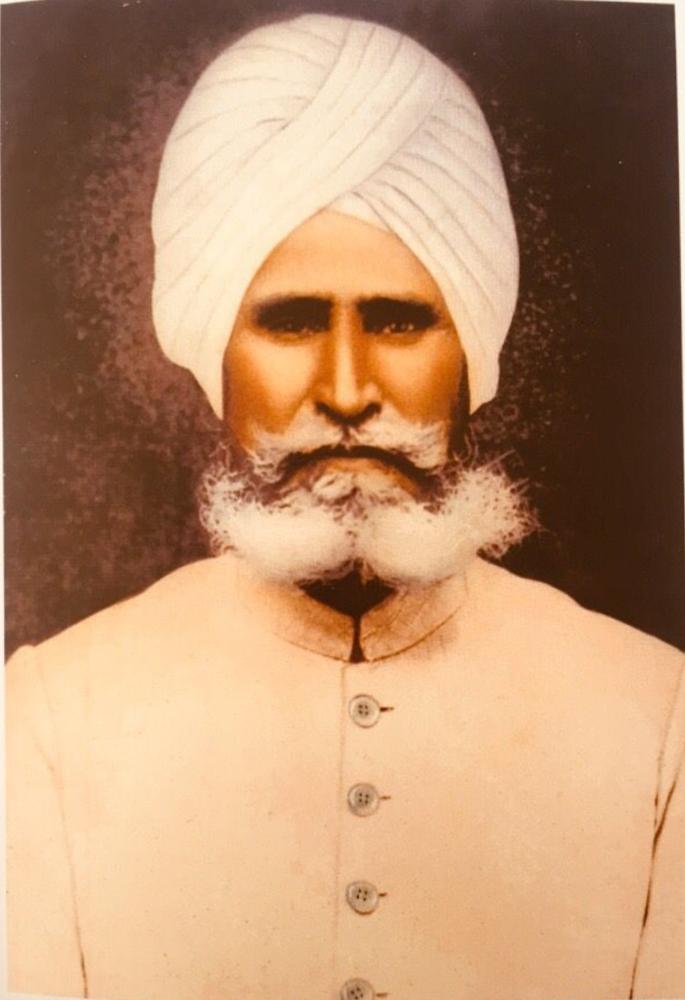Rai Bahadur Sardar Narain Singh Of Akoi was the son of Sardar Chanda Singh Of Akoi , He belonged to the Khangura Jat clan, and was born in the village of Akoi Sahib, situated about three kilometres from Sangrur, Punjab.
The history of the family relates to an ancestor who with his friend, a Brahmin (name unknown), left their ancestral village of Bhiwani (now in Haryana), with a few buffaloes and travelled towards Sangrur, where they settled on barren land, which came to be known as Akoi Sahib. The word «Sahib’ is a suffix for those villages and towns that were later visited by the Sikh Gurus, and thus Akoi Sahib village, was fortunately visited and blessed by Guru Nanak Dev ji, Guru Hargobind Rai ji, Guru Tegh Bahadur and Guru Gobind Singh ji.
Sardar Chanda Singh owned a small swathe of agricultural land, that barely provided a decent living to feed the family. The low wing hand was usually flooded during the monsoon season, and provided very little crops to sustain the family. Later, his son Sardar Narain Singh was recruited into the find forces as a Sepoy, and earned about seven rupees a month. He was educated till grade four, and was proficient in Urdu and Gurmukhi. Having a flair for mathematics, he possessed an analytic mind with a photographic memory.
A British engineer, Samuel Swinton Jacob accompanied by his wife, visited Sangrur, on the invitation of the Maharaja of Jind, to redesign the town on modern lines. The British engineer requested the Maharaja of Jind, if Sepoy Narain Singh could join him as his understudy, in the construction work, that was planned for the new capital of India, which was going to be shifted from Calcutta to Delhi.
Sardar Narain Singh was earlier given a contract to built a part of the Patiala tunnel, by the Maharaja of Patiala. The job was so well done, that he was flooded by prestigious contracts, including the grand Coronation Durbar in 1911, when the British shifted the capital to Delhi, with King Emperor George V and Queen Empress Mary, laying its foundations.
Later, he arrived in Delhi, and after a short struggle, managed to procure working under contractors, Sir Edwin Lutyens and Sir Herbert Baker, the renowned architects. He obtained the contract to build new roads in New Delhi. Thereafter, there was no looking back, and he tirelessly worked on Rashtrapati Bhavan (Viceroy House as it was known), Lady Hardinge College and Hospital, Eastern Court and
Western Courts, shops in Connaught Place, Windsor Mansion on Janpath Road (formerly known as Queens Way), a huge house on Barakhamba Road, which now houses a 17 storey commercial complex, known as Narain Manzil. Rai Bahadur was given even larger contracts, including The Imperial Hotel. This was followed by an invitation to build Dehradun, the beautiful valley in the northwest part of India, also known for its proximity to such tourist attractions as Mussoorie, the Queen of Hills, and the spiritual hubs of Hardwar and Rishikesh. As part of the master plan, Rai Bahadur Sardar Narain Singh was asked to build the Prince of Wales College, Don School and the Forest Research Institute in Dehradun.
Rai Bahadur Narain Singh was one of the four contractors, who built New Delhi to the design of the ‘Delhi Town Planning Committee’ led by Sir Edwin Lutyens, Sir Herbert Baker and Sir Samuel Jacob. The Imperial Hotel on Queens Way (now Janpath), was in the original master plan, although it wasn’t built until
- Sardar Narain Singh was honoured with the title of ‘Rai Bahadur Sahib’ and awarded the Durbar Medal in recognition of his splendid work. Some of his other notable achievements,
were building several rail bridges, between Delhi and Dehradun; spinning mills in Montgomery (now in Pakistan), developed the village of Mandauli in Delhi; set up a tent factory in Shahdara, Delhi, for the war effort in
1939; bought and developed 2500 acres of agricultural land in Sri Ganganagar, Rajasthan, which he developed as a modern mechanised seed producing and cotton growing farm, by importing tractors and harvesters from England and America.
His other ventures included having settled thousands of Punjabi farmers, for the Ganga Canal project, and bought land on which he constructed a flour mill, an ice factory and a cinema hall in Bathinda, Punjab. Rai Bahadur Narain Singh was instrumental in leading the agitation movement for acquring the historic land at Sri Sis Ganj Gurdwara, from the local authority (kotwali) that had been the spot where Guru Tegh Bahadur was martyred in 1675. Also, he had built the outer wall around Sri Rakab Ganj Gurdwara outside Parliament, which formerly belonged to the British Government. Lastly, he had fought in the second Afghan-War, which earned him a medal for bravery, for transporting ammunition and supplies to the Indian troops, during battle in enemy territory. He had married twice, first to Sardarni Attar Kaur, and then to Sardarni Labh Kaur, from village Maur, near Sangrur. On his death, he was succeeded by nine children, from both his marriages. His eldest son, Jagjit Singh, from his first wife, Sardarni Attar Kaur, was married to Chand Kaur, and was blessed with two daughters; Ravinder Kaur married Sardar Sarabjit Singh Gill, and Darshan Kaur married, Sardar Satinder Singh, of Manauli.
- The Punjab Chiefs By Bobby Bansal


